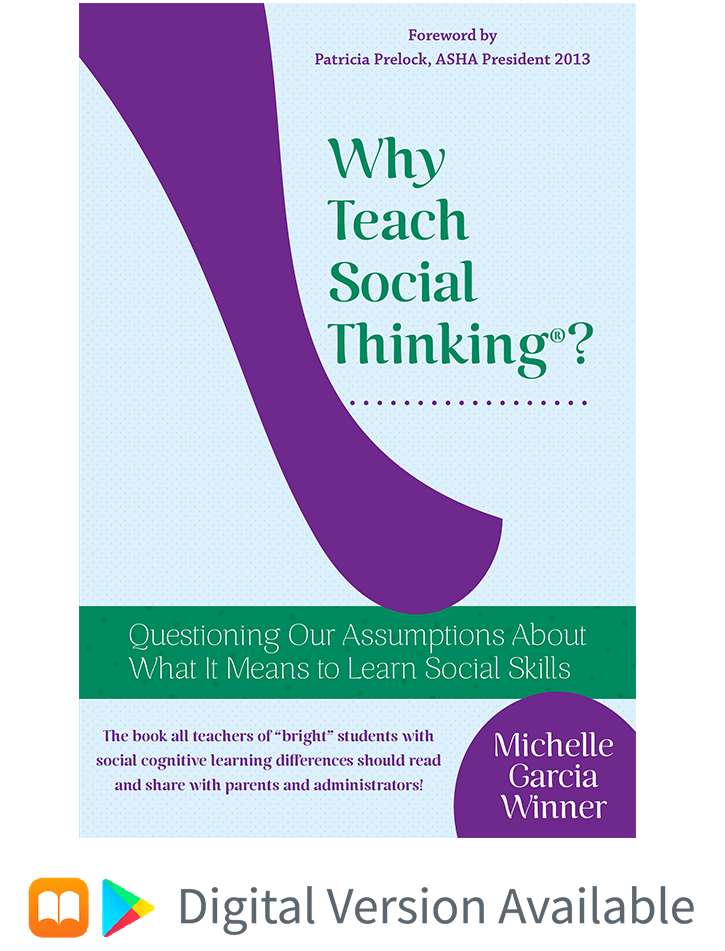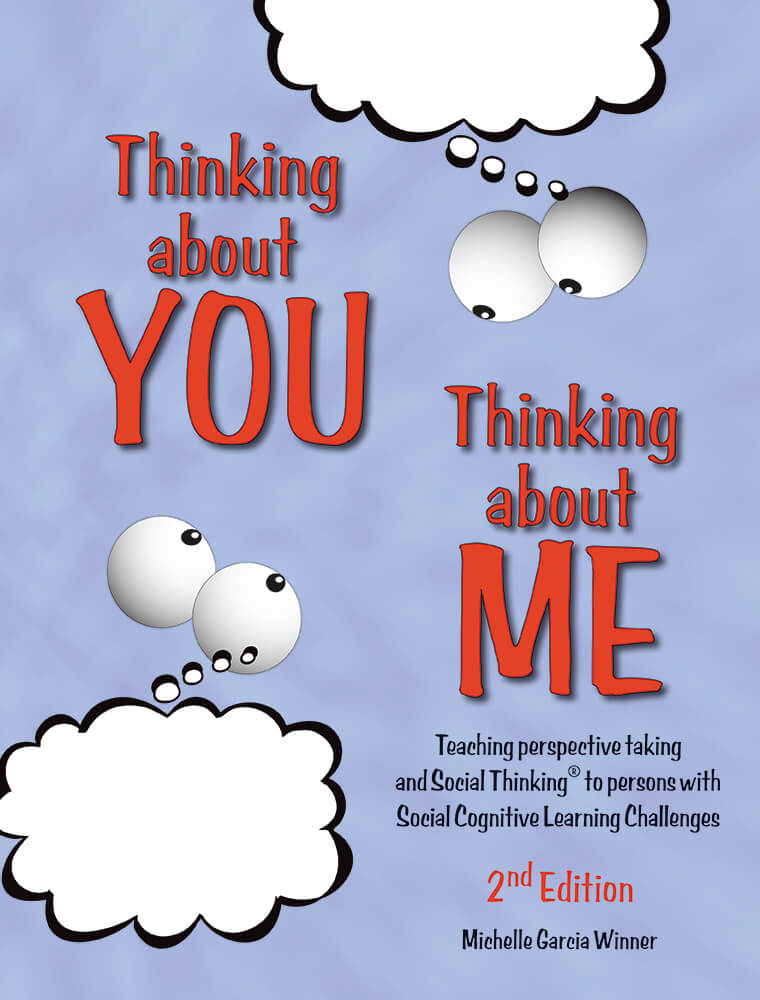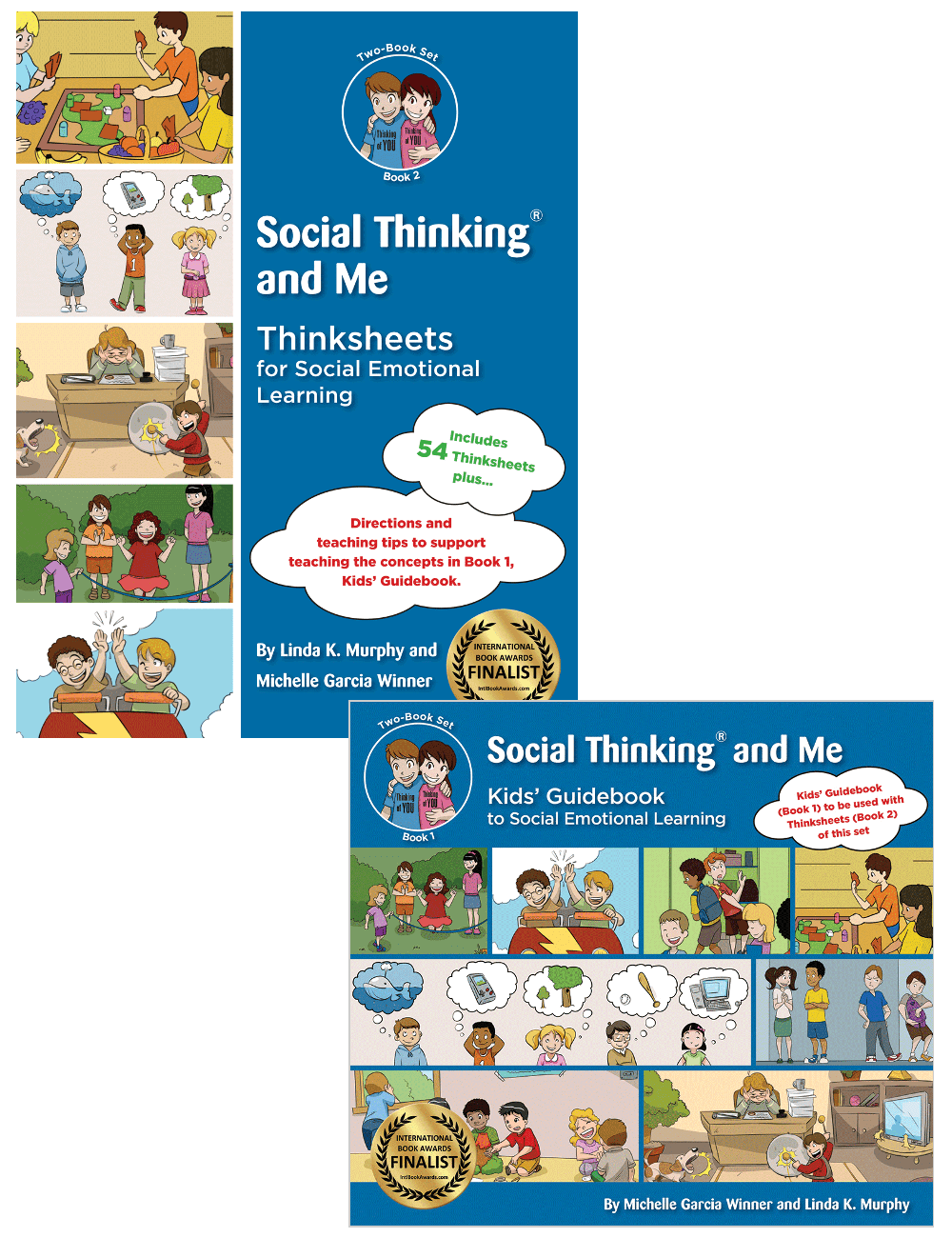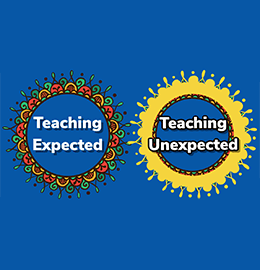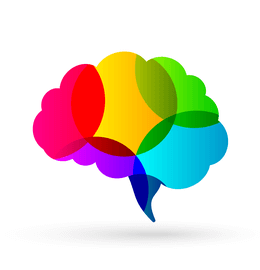Updated: August, 2022
© 2022 Think Social Publishing, Inc.
I gave a full-day training to the entire teaching and specialist staff for a school district in California to help them learn how to teach students to relate more effectively in peer-to-peer project-based learning situations, working as a classroom group, etc. It was a pleasure to work with and continue to learn from the teachers, specialists, and parents. Throughout the day one sentiment surfaced again and again: that while teachers are taught “classroom management skills” as part of their education and training, they’re never really taught how to help their students with social-emotional differences and/or challenges, nor teach social competencies that so often influence academic success in school. In essence mainstream teachers are “social developmental specialists” for the age groups they teach, yet most struggle with figuring out how to both teach these concepts and skills to their students and communicate with parents about the needs of children for whom social learning doesn’t come naturally.
That same evening, I led a parent education meeting in that district. My focus was not only to talk to parents about the Social Thinking® Methodology and social learning but to share with them the dilemma their children’s teachers echoed to me: “How can we talk to parents about our observations when we notice their child is socially awkward or has difficulty engaging in group learning, especially when that child is academically bright?”
The following nine suggestions and “thinking points” are offered to encourage collaborative discussions between professionals and parents. This information is intended to apply broadly to all who share the goal of helping our students with social learning differences and/or challenges continue to evolve in their social competencies.
- Get comfortable with the topic by better understanding it. Administrators and teachers are comfortable talking about a child’s difficulty with reading decoding, spelling, or figuring out math problems but social problems seem to be very difficult to discuss. While the teachers echoed this, few could explain why. My guess is that the social process isn’t all facts; it engages our emotional system. What we do and say impacts how others think and feel and most educators and learning specialists are not comfortable talking about their own and others’ emotional interpretations. They also don’t like to cause discomfort when talking to family members. Plus, when we’re talking about social abilities, we’re stepping into largely uncharted and unqualified territory, one that doesn’t have any type of standardized measurements that remove the subjectivity around social observations. So we’re often at a loss for not only what to say and how to phrase these observations, but how to measure the social gaps we notice and offer some concrete plan for improvement. The following tips will help to develop comfort with these discussions.
- Talking about “social learning” rather than social skills. To help parents and professionals discuss the differences or challenges, we encourage everyone to discuss the problem with user-friendly language. When our team works with parents we explain that when looking through the lens of the Social Thinking Methodology, a person’s social skills (behaviors) are a by-product of how that person interprets and responds to the situation and the people around them. People who show what others describe as socially awkward behavior do not have a behavior problem; it is a social learning problem.
This thinking is closely aligned with that of Dr. Ross Greene, creator of Collaborative & Proactive Solutions (www.livesinthebalance.org). Dr. Greene describes students who exhibit challenging behaviors as having lagging skills that lead to unsolved problems. In a nutshell, despite a student’s desire to interact, they may not know how to figure out the situation. Think about a student who has persistent social skills differences or challenges. They are experiencing daily unsolved problems, one after another. As a result, a peer may struggle to interpret our student’s intentions, emotions, or thoughts because the student’s social behaviors are confusing for the context of the situation. Through the lens of the Social Thinking Methodology, we carry Dr. Greene’s thinking one step further and propose that our students are experiencing lagging social concepts and skills. I don’t think it’s just skill development that is lagging but also how their brains process social information to make sense of the context and what they know about the people in the situation. In teaching we need to address how we each create social goals, how we interpret social cues, how people interpret our social cues, how to recognize and manage anxiety and other stressful emotions. This is far more than teaching social skills! This involves executive functioning, language, recognizing points of view, etc.
- Explore social competencies. We teach that people start by interpreting socially-based information while also experiencing related emotions. This happens prior to figuring out their social responses (what some call social skills). This interpretive and emotional process occurs not only when interacting face-to-face with one or more persons, but also when sharing space with others whether interacting or not. This also occurs when observing to interpret social information (e.g., watching a weekly TV show, watching the news, reading a novel, studying history or social studies, etc.). Consider the many times in a day or week when you are surrounded by people you have no plans to talk to. You still use your social thinking to interpret your surroundings, figure out the expectations of the people, gauge your emotional reaction, and then adapt your behavior (social skills) based on the social goals you want to achieve. Most often when we’re surrounded by others we do not plan to interact with (such as when listening as part of a group in a classroom), our social goal is simply to share space effectively.
This idea is important to consider, because it means that when teaching social competencies, we need students to learn to observe people in context to learn when (and how) to interact or not interact or share one’s thoughts out loud! When we focus on social competencies (the thoughts, emotions, interpretations, actions, reactions, and other thinking and behaviors involved) we make the important shift away from simply teaching social behavior to introducing and teaching students about social thinking and deeper social concepts.
- Recognize that social learning is one of many learning systems. This perspective toward teaching social competencies through our social thinking and related social skills aligns with Howard Gardner’s theory of multiple intelligences (Gardner, 1983) in which he described eight different “intelligences” that guide how people process information. Our social thinking and related social skills are part of our social cognitive processing and responses that influence our interpersonal and intrapersonal skills.
- Get organized around how we socially relate. One way is to use Teaching Frameworks found in the Social Thinking Methodology (STM) is to teach how the social world works. Components of the STM are designed to help us all become more aware of our own social perceptions, expectations, and interpretations and then organize our social observations around specific social ideas and frameworks. A few of our frameworks are summarized below.
- The Four Steps of Perspective Taking
- The Four Steps of Face-to-Face Communication
- The Social Emotional Chain Reaction
- Help students find their own motivation. Most social skills programs begin with the assumption that they need to teach students how to change their behaviors. Many of our students in upper elementary, middle, or high school are reluctant to participate in programs that push behavior change without attempting to appreciate the student’s social abilities and work from a strength-based approach. We have found most of our students become more motivated socially when we encourage them to notice how much they already engage in the social world through the strong expectations they have for others
We then study the social-emotional chain reaction to help them explore that they have thoughts and feelings about people around them, even people they don’t talk to, and that they care how people treat them. From there we encourage them to become stronger social detectives and report back on what they are noticing about different aspects of the social world. - Use a common vocabulary. We use Social Thinking Vocabulary to teach strategies our students can use to expand these social investigations and interpretations, help them be aware of how they perceive what others do and say and then explore how others may perceive what they do and say. Some of our many strategies that help to expose the social code include but are not limited to:
- Expected and unexpected behavior based on the situation
- Think with your eyes
- Body/brain in the group
- Smart Guess
- Read the plan
- Teach social learning in a developmental manner. Social expectations change with age and social learning always aligns with social emotional learning. Many school districts are now recognizing the value of teaching social emotional learning to all students, as longitudinal research is demonstrating that one’s social emotional learning abilities are powerful predictors of success not only in school but throughout our adult years (www.casel.org).
Within the larger Social Thinking Methodology, we have created developmental frameworks and strategies that align with Casel’s five aspects of social emotional learning: self-awareness, self-management, social awareness, relationship skills, and responsible decision making. These materials help guide parents and professionals to the Social Thinking Vocabulary concepts and strategies that are on point for a student’s social stage of development. Examples of these tools include our early learner (ages 4-7) curriculum series We Thinkers! Volume 1 Social Explorers and Volume 2 Social Problem Solvers; our Superflex curriculum series (grades 3-5); Social Thinking and Me (grades 4-7), and materials for adolescents such as Socially Curious and Curiously Social, and Social Fortune or Social Fate.
- Read and relate. We often encourage mainstream teachers, parents, and other professionals to read through our folksy student-centered teachings and then relate the information to their own lives. As adults make sense of the Social Thinking Methodology’s teachings, noticing how our concepts and strategies apply to their own life, they will naturally become more comfortable talking about the social learning process as more than a set of social skills. Our goal is to help take implicit social information and make it explicit. This creates collaboration and moves us toward developing meaningful social learning teachings and related social competencies that can be broadly applied in school, community, and home, and that will continue to evolve with age and direct social learning instruction across our students’ lives.
We provide other helpful and informative materials via the many free articles on our website, including this one: Why Use the Social Thinking Methodology? 19 Concepts to Consider. These are not just teaching tools for special educators or folks on mental health teams; they’re for everyone. We hope you find our many resources helpful for fostering more productive discussions about social learning as you begin the journey of creating social learning lessons and programs for all!
Bibliography
Jones, D.E., Greenberg, M. and Crowley, M. (2015). “Early Social-Emotional Functioning and Public Health: The Relationship Between Kindergarten Social Competence and Future Wellness. American Journal of Public Health: Vol. 105, No. 11, pp. 2283-2290. doi: 10.2105/AJPH.2015.302630.
Gardner, H. (1983). Frames of Mind: The Theory of Multiple Intelligences. New York: Basic Books.
Gardner, H. (1993). Multiple Intelligences: The Theory in Practice. New York: Basic Books.
Gardner, H. (1999). Intelligence Reframed: Multiple Intelligences for the 21st Century. New York: Basic Books.
Greene, R.W. (1998, 2014). The Explosive Child: A New Approach for Understanding and Parenting Easily Frustrated, "chronically Inflexible" Children. New York: Harper Paperbacks.
Greene, R.W. (2008, 2014). Lost at School: Why Our Kids with Behavioral Challenges Are Falling Through the Cracks and How We Can Help Them. New York: Scribner, 2008, 2014.
Greene, R.W. (2016). Lost and Found: Helping Behaviorally Challenging Students (and, While You're at it, All the Others). San Francisco: Jossey-Bass.
Greene, R.W. (2016). Raising Human Beings: Creating a Collaborative Partnership with Your Child. New York: Scribner.
Greene, R.W., and Ablon, S. (2006). Treating Explosive Kids: The Collaborative Problem Solving Approach. New York: Guilford Publication.
“What is SEL” and “Core SEL Competencies.” (2016, October 18). Retrieved from www.casel.org/what-is-sel/










